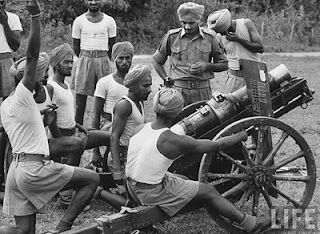This blog is a comprehensive and in-depth guide to the events, people and places throughout the history of India
Saturday, October 20, 2012
Annexation of Kabul by Akbar
Akbar's Mausoleum
Friday, October 19, 2012
Indo-Sino War 1962: A Retrospect
 |
| Indian troops during a military training drill in Assam - Indo-Sino War 1962 |
All was well till Panch Sheel (Five Principles as the basis of their friendly relations) was signed between these two countries on 20th April, 1954. All these changed when China, in utter disregard of the Panch Sheel, published maps where 132, 090 square kilometers of Indian territory were included wrongly. The situation came to a head when China overran Tibet in 1959 and Dalai Lama, the spiritual head of Tibet, and a large number of Tibetans were forced to take refuge in India. Meanwhile China occupied approximately 31,000 square kilometers of Indian territory.
 |
| Chinese troops during the Indo-Sino War 1962. |
Thursday, October 18, 2012
Mattavilasa Prahasana, The Delightful Farce
Mattavilasa Prahasana (the Sport of Drunkards) was written by the versatile Pallava ruler and scholar Mahendravikramavarman or Mahendravarman I, a contemporary of Harsha.
Set in the Pallava capital of Kanchipuram, this little farce treats of a drunken Shaivite ascetic named Kapali or Satysoma, who loses the skull which he uses as begging bowl and accuses a Buddhist monk Nagasena of stealing it. After a drawn -out argument involving satirical dialogue, in which other dissolute mendicants of various persuasions and both sexes are involved, it is found that the skull has been stolen by a dog. Replete with Rabelaisian humour, this short one-act play in Sanskrit throws a flood of light on the life of the 7th century India.
Last Days of Chandragupta Maurya
Sunday, September 30, 2012
Farrukhsiyar
Friday, September 21, 2012
Alberuni, the celebrated traveller to India and a Great Scholar
One of the most famous Arab travellers to India, Alberuni (Al-Biruni) visited India when Mahmud of Ghazni invaded Somnath, the famous shrine in Gujarat dedicated to Lord Shiva. Between 1001 and 1027 Mahmud made seventeen raids on India. One of the main objects of his raids was to acquire the wealth of India. Naturally so, the temples and towns were his main targets because they were repositories of immense wealth. As a result of his campaigns, many temples were looted and desecrated. Enormous caravan of booty and slaves were taken to Ghazni. Mathura and Kanyakubja, the great cites of India at that time, were plundered.
Also called Abu Raithan, Alberuni spent his years in India in the study of astronomy, medicine, chemistry, etc,. His book Tahkik-i-Hind (reality of Hindustan or Enquiry into India), a voluminous work divided into 80 chapters, is a mirror of the eleventh century India. The magnum opus gives a good graphic description of India as the great scholar saw the country. In fact, the book is “a magic island of quite impartial research in the midst of a world of clashing swords, burning towns and plundered temples.”
Alberuni writes about Indians. He says, “They are haughty, foolish, vain, self-conceited, stolid. They are by nature niggardly in communicating that which they known…According to their belief, no other created beings besides them have any knowledge of science whatsoever.”
Manyakheta, Rashtrakuta capital
Image Credit Manyakheta was the capital of the Rashtrakuta dynasty which ruled large parts of southern India from 753 to 973. The capital ...

-
Aurangzeb, the last great Mughal emperor, died in 1707. Muhammad Shah became Mughal emperor in 1719. During the interregnum, Bahadur Shah I...
-
Books Authors Abhigyan Shakuntalam (Recognition of Shakuntala) Kalidasa Aihole ...
-
Amir-i-Chahalgani, known variously as Turkan-i-Chahalgani and Chalisa (The Forty), was a group of 40 faithful slaves which came into existen...


